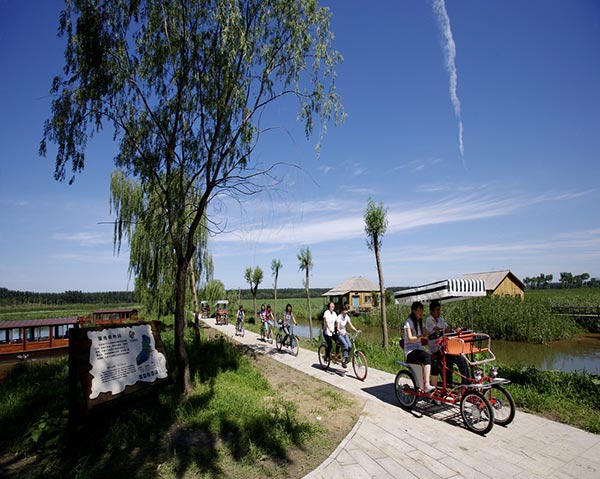A prescription to protect 'the Earth's kidneys'
Updated: 2015-12-23 07:55
By Xu Lin(China Daily)
|
||||||||
 |
|
Boats with tourists at the Health Bridge Wetland Park in Beijing's Shunyi district. The park keeps tourism promotions to a minimum and restricts visitor numbers to protect the wetland. [Photo provided to China Daily] |
"If birds fly out of the reserve, we drive cars to direct the birds back in, like sheepdogs," Li says.
The trick is ensuring human interference is at best helpful and at least not harmful.
The NGO also hosts an encounter program in which adults and children learn how to identify flora and fauna, and record data about them.
They can then work the monitoring stations-making their own contributions to wetlands' protection.
Li and his colleagues fence off the areas beneath nests of the nationally protected black storks during the April breeding season to prevent human intrusion.
They place pork on mountains to prevent vultures from preying on villagers' sheep.
"Properly managed ecotourism supports, rather than strains, wetland protection," says Wang Lei, a researcher from the Science, Policy and Innovation Center of the World Wildlife Fund's Beijing office.
She suggests authorities consider wetlands' fluctuating capacities to accept visitors during different seasons when planning their tourism strategies.
One management problem nationwide is that different departments of the central and provincial or municipal governments are involved in managing wetlands, creating confusion, and the diffusion and overlapping of responsibility, she says.
The central government first proposed establishing a national-parks system in 2013.
China's National Development and Reform Commission signed agreements with the US-based Paulson Institute in June to explore new management models in scenic spots and heritage sites in Beijing and eight provinces.
Wang believes this is an innovative way to tackle the problems protective zones face, such as overlapping jurisdictions and divided land ownership.
Many successful cases overseas can be studied. The World Wildlife Fund is researching system-building methods in China.
The government's plan announced this year to integrate Beijing, Tianjin municipality and Hebei province into a conurbation provides new opportunities for wetlands.
Beijing will link its wetlands to those of Tianjin and Hebei's Langfang and Baoding by 2020, the capital's forestry bureau says.
About 3,000 hectares of wetlands will be created in Beijing's suburban areas adjacent to Tianjin and Baoding's suburbs.
Related:
Shunyi stages first winter carnival
Birds fly in Mingsha Mountain in NW China

 Whatever the shape or size of a tree, Merry Christmas!
Whatever the shape or size of a tree, Merry Christmas!
 The world in photos: Dec 14 - 20
The world in photos: Dec 14 - 20
 First American woman who works as captain for a Chinese airline
First American woman who works as captain for a Chinese airline
 Life of a family amid Beijing's red alert smog
Life of a family amid Beijing's red alert smog
 External coffin lid of 2,000-year-old Chinese tomb opened
External coffin lid of 2,000-year-old Chinese tomb opened
 First Miss Iraq named in decades
First Miss Iraq named in decades
 Iraq holds its first beauty contest in 40 years
Iraq holds its first beauty contest in 40 years
 Highlights at the Light of the Internet Expo
Highlights at the Light of the Internet Expo
Most Viewed
Editor's Picks

|

|

|

|

|

|
Today's Top News
Shooting rampage at US social services agency leaves 14 dead
Chinese bargain hunters are changing the retail game
Chinese president arrives in Turkey for G20 summit
Islamic State claims responsibility for Paris attacks
Obama, Netanyahu at White House seek to mend US-Israel ties
China, not Canada, is top US trade partner
Tu first Chinese to win Nobel Prize in Medicine
Huntsman says Sino-US relationship needs common goals
US Weekly

|

|








